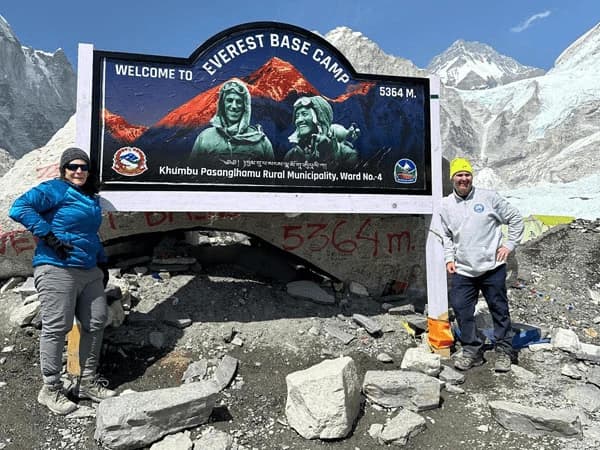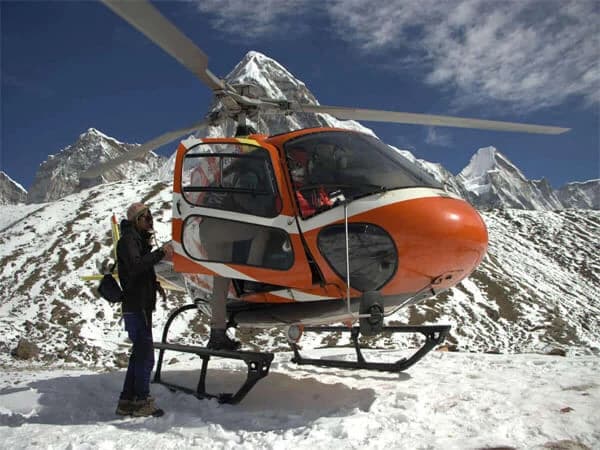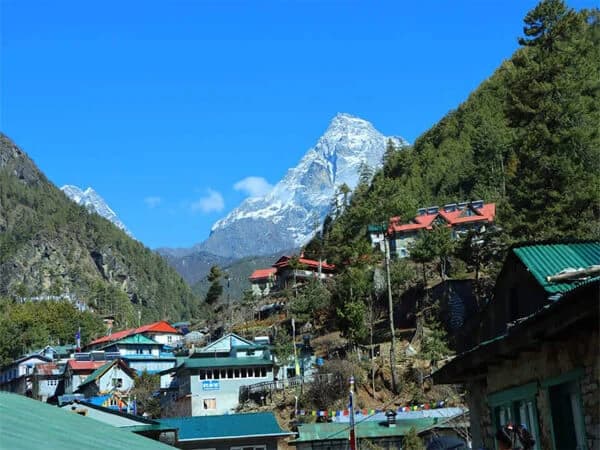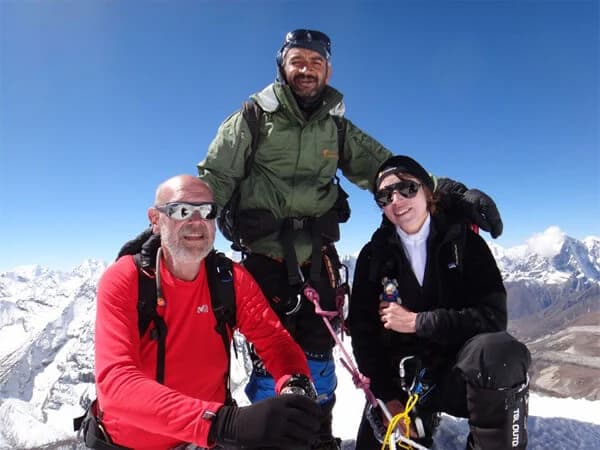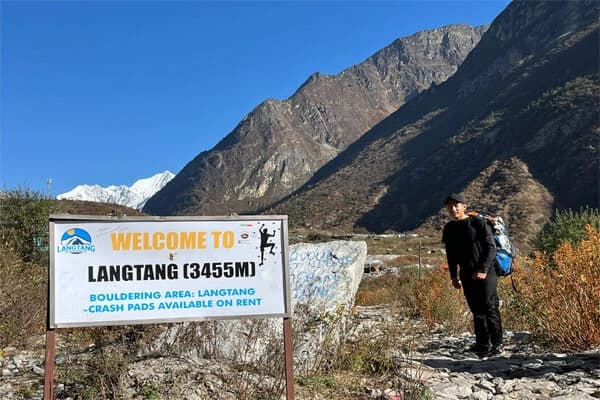Everest Base Camp Trek and K2 Base Camp Trek are both challenging trips in the Himalayas. Yes, the degree of challenge differs from one to the other trip. Everest Base Camp Trek takes you to eastern Nepal in the Khumbu Region. K2 Base Camp Trek takes you to the northwestern part of the Karakoram Range in Pakistan.
Although the Everest Base Camp Trek is more popular and frequently done than K2 Base Camp Trek, the daredevils prefer doing both. This blog will help you find out “Which is more challenging: Everest Base Camp Trek or K2 Base Camp Trek?” To assess more challenging trip between EBC Trek and K2BC Trek, the following things are important to know about:
- Trails of EBC Trek and K2BC Trek
- Modes of River Crossing during EBC Trek and K2BC Trek
- Weather Conditions of EBC Trek and K2BC Trek
- Food and Accommodation in EBC Trek and K2BC Trek
- The remoteness of Everest Base Camp Trek and K2 Base Camp Trek
- Rescue Operations during EBC Trek and K2 Base Camp Trek
- Altitude Sickness during EBC Trek and K2BC Trek
- Financial Challenges of EBC Trek and K2BC Trek
- Other Challenges of EBC Trek and K2BC Trek
- Trails of EBC Trek and K2BC Trek
Trails of a particular trekking destination determine the trekking difficulty level. Generally, the trekking destination that is frequently visited has better trail conditions than off-the-beaten-path trekking destinations.
In addition, whether the trekking trails are populated or deserted also defines the condition of trekking trails. When people reside around the trekking trails, they work together to maintain the trails if damaged. On the contrary, if the trekking routes are deserted, there is less possibility in maintaining the damaged sections.
The Everest Trekking Region is one of the most frequented trekking destinations in the world, not only in Nepal. The Khumbu Region trek is the home to Sherpas, who are synonymous with trekking and mountaineering in the world.
Everest Base Camp Trek route begins from Lukla and moves higher along the Sherpa villages reflecting the Tibetan culture and tradition. The trails of Everest Base Camp Trek are well defined with all the signposts that help the national and international trekkers to follow the right direction.
The distance from Gorakshep to the base camp of Mount Everest (8,848.86m) is 3.5 km which requires from 4-5 hours. This section is the most challenging part of the whole Everest Base Camp Trek. The trail from Gorakshep to EBC (5,364m) is rocky and rough.
The high altitude makes it more challenging, yet joyous due to the amazing sights. While traversing along the slippery trail, you enjoy the close-up views of the Khumbu Icefall, the Khumbu Glacier, and the wonderful landscapes atop the world. Taking some precautions against AMS can help you reach to the destination and trek back to Gorakshep (5,164m).
On the other hand, the K2 Base Camp trek is rather more challenging than the EBC Base Camp Trek. From Islamabad, you take a domestic flight to reach to Skardu whereas drive for two days along the Karakoram Highway (KKH). The road from Islamabad to Skardu is not perfect for driving but is really scenic. While moving in a private jeep or four-wheeler, you enjoy the tallest peaks of Pakistan including five 8,000ers.
K2 Base Camp Trek formally begins from Askole which takes a day’s drive from Skardu. The road between Askole and Skardu is winding and slippery and crosses over the Indus River near the confluence of the Shigar River.
Moving further, the road moves along the Braldu River edges, so it is prone to landslides. This section sometimes may get blocked while doing K2 Base Camp Trek in the monsoon season. However, the local drivers are wise and determined they take you up to the destinations by implementing alternative options.
From Paiju across the Baltoro Glacier up to Concordia, the trekking trail is made up of loose rocks with several ascents and descents. The movement of the ice mass changes the trail every year. The track further is not well defined and lacks signposts but in some places, the cairns along the trail guide you up or down the K2 Base Camp (5,151m).

Because most of the trail is covered with thick layers of ice, you need crampons and trekking poles. Mountaineering skills and experience are necessary for a successful ascent of Mount K2 (8,611m). As you move forward from Gore 2 Camp to Concordia, the trail becomes wider and more comfortable. By walking through the moraines, you ascend towards Broad Peak Base Camp (5,000m).
As an alternative to K2 Base Camp and Concordia Trek, you can follow K2 Base Camp and Gondogoro La Pass Trek. This route is the ultimate way to escape the Baltoro Glacier while returning from K2 Base Camp. It descends across Gondogoro La Pass (5,560m) and ends at Hushe Village. From this village, you catch a jeep to drive back to Skardu.
Modes of River Crossing during EBC Trek and K2BC Trek
The mode of river crossing during EBC Trek and K2BC Trek is different. There are a few snow-fed rivers en route EBC Trek and K2BC Trek. These Himalayan Rivers are fast-flowing, so challenging to cross them on foot.
The Everest Base Camp Trek route has suspension bridges over the rivers. You don’t have to worry about crossing these rivers. Only the bridge nearby Dughla over the Lobuche River that originates from the Khumbu Glacier is small.
While trekking in Pakistan, especially in the Karakoram Region, the bridges are not constructed over the rivers en route. While doing K2 Base Camp Trek, you may have to cross the rivers on foot. As these rivers originate from the Karakoram Mountains, their sizes increase in the sunshine.
Along with the size, the rivers’ current grows faster than in the mornings and the evenings. Therefore, you have to cross these rivers early in the morning to minimize the risk. Moreover, the trekking poles and your trekking guides help you cross the rivers safely.
Weather Conditions of EBC Trek and K2BC Trek
The weather conditions of EBC Trek and K2BC Trek are different although they both lie in high altitudes. The best time for K2 Base Camp Trek is July and August, which are hot summer months. The average temperature of the Karakoram Range is above 30 degrees Celsius in this season but there are few trees for shade.
The Karakoram Mountains lie in the rain shadow areas of the Himalayas as Nanga Parbat (8,126m), so the Karakoram Region gets less precipitation. However, it may rain most often in this region. So, we recommend you carry an umbrella to protect yourself from rain and scorching sun. Thus, don’t forget to keep your things such as waterproof jackets and trousers in waterproof bags.
On the other side, the best time for Everest Base Camp Trek is either spring (March-May) or autumn (February-November). These peak seasons have clear skies with stable weather that serve you picturesque vistas of the snowcapped peaks and wonderful landscapes. Mornings and nights are cool while the daytime is warm. We recommend you carry multilayered clothes that fit in cold and hot weather.
Even if the weather turns out to be unfavorable, you can wait for a couple of days to complete the EBC Trek. Alternatively, you can cancel the trip and return to the Kathmandu Valley. It is easier to wait for or cancel EBC Trek than K2BC Trek.
Food and Accommodation in EBC Trek and K2BC Trek
K2 Base Camp Trek is a mixture of teahouse and camping trekking whereas Everest Base Camp Trek is entirely a teahouse trekking. Food and accommodation services differ in camping trekking in Pakistan and teahouse trekking in Nepal.
In camping trekking, you have less choice in food and accommodation facilities because you have to depend upon the food items carried by the crew. K2 Base Camp Trek route doesn’t have teahouses, so your crew members carry food items sufficient for 5-6 days.
While in K2 Base Camp Trek, you have to spend 5-6 days in the Frigid Zone, so you cannot even get to heat your food. If it rains, you cannot dry out your clothes in your tented camps. You have to spend these nights in the tented camps set up above the snow.
On the contrary, the Everest Base Camp Trek route has basic to luxury hotels from Lukla to Gorakshep (5,164m). Even in snowy and rainy seasons, the Everest Base Camp trekkers can get food and accommodation in teahouses and lodges.
No matter, how bad the Everest Region weather might be, the food and accommodation services are available on the trip. Even if your clothes are wet, you can dry them on ovens or use iron for the purpose. Most of the teahouses of Everest Region Trek have electricity, so you can get warm to protect your body from extreme coldness. Likewise, these teahouses have attached bathrooms and hot showers.
In this way, for food and accommodation services also, the K2 Base Camp Trek is more challenging than the Everest Base Camp Trek.
The remoteness of Everest Base Camp Trek and K2 Base Camp Trek
Everest Base Camp Trek is done by around 30,000 national and international trekkers every year whereas K2 Base Camp Trek by 1,300. The reason behind the lowest number of trekkers to K2 Base Camp is the remoteness of the Karakoram Region.
Because of the development of tourism infrastructure in the Everest Region, both novice and avid trekkers dream of doing EBC Trek. Up to 3.5 kilometers below the base camp of Mt. Everest (5,364m), you find teahouses with basic services of food and accommodation. Gorakshep (5,164m) has four teahouses that can accommodate around 400 trekkers a night.
The regular route of Everest Base Camp Trek moves along the Sherpa villages of the Khumbu Region. You can see centuries-old monasteries, mane walls, prayer flags, and wheels throughout the villages. Along with the scenic view of the snowy peaks, you can enjoy the Tibetan culture and tradition in the Sherpa villages.
K2 Base Camp Trek begins from Askole which is the last human settlement area and ends at the same village. You don’t see any human settlement areas throughout the entire trip. Instead of villages, you will see some trees in the lower region and only the black mountains in the upper region.
Except for snowy mountains, you don’t see anything around the Nepal trekking trails of K2 Base Camp Trek. The trail is deserted due to the lack of tourism infrastructure and unfavorable weather conditions. Moreover, the landscapes of the Karakoram Mountains are not supportive of human settlements.
Rescue Operations during EBC Trek and K2 Base Camp Trek
Rescue operations are important while trekking in high-altitude Himalayan regions. In some critical circumstances such as AMS, landslides, floods, bruises, sprains, and fractures, rescue operations are necessary.
If any accident occurs during Everest Base Camp Trek, you can get emergency rescue operations via helicopter. There is helipad in almost all the stopovers of the Everest Base Camp Trek route. You can ride over Everest in a helicopter if you don’t want to trek any longer or you fall sick.
But during K2 Base Camp Trek, if any accident takes place, it is not that easy to get rescue operations. The terrains of the Karakoram Region are remote and unpredictable, so lack helipads. If you have to cancel the trip in the middle, you don’t get helicopter rescue services during K2 Base Camp Trek.
Altitude Sickness during EBC Trek and K2BC Trek
The Everest Base Camp Trek difficulty level is moderate to challenging while the difficulty of the K2 Base Camp Trek is challenging to strenuous. The highest altitude to reach in Everest Base Camp Trek is Kalapatthar (5,644.5m) whereas in K2 Base Camp Trek is the base camp of K2 with 5,151m.
As soon as one goes higher than 2,500m, there is a possibility for Acute Mountain Sickness (AMS) like altitude sickness. There is high potential for altitude sickness during both the treks as they are higher than the given level.
However, by taking some precautions to avoid AMS, you can complete the treks. Due to the availability of teahouses, first-aid boxes, clinics, etc. Everest Region Trekking has a lower probability of altitude sickness than in K2 Base Camp Trek.
Financial Challenges of EBC Trek and K2BC Trek
Financial aspects also contribute to making a trek more or less challenging. The cost of teahouse trekking is generally lower than that of camping trekking. For a camping trekking, you need to hire a crew containing a few members. But for teahouse trekking, you can do the trekking with a single trekking guide or a porter.
For K2 Base Camp Trek, you need to pay for the crew as it is a camping trek in Pakistan. For Everest Base Camp Trek, you can simply travel as a free individual trekker (FIT) as it is not a restricted area trekking in Nepal. You have choices of food and accommodation during the Everest Trek whereas no such choice in the K2 Trek.
In this way, the financial challenges of EBC Trek are higher than in K2 Base Camp Trek.
Other Challenges of EBC Trek and K2BC Trek
Besides the challenges listed above, there might arise several obstacles while doing both the trek. Trekking in the Himalayas is always challenging physically and mentally. Various natural and manmade challenges appear during the treks.
For successful completion of EBC Trek and K2BC Trek, you need to maintain your physical health with strong willpower and determination. Your physical condition and habit of taking challenges also determine the success of your trek.
Above all, the local tour operator you book your trip with also matters while trekking in Nepal and Pakistan. You should always choose the authentic agency that provides you with the best professional guides and crew members. The local tour operator that prioritizes your safety and satisfaction should be chosen or consulted with.
If you feel more challenges we do have the trek called Everest Base Camp Trek with Helicopter Return.
Conclusion
It is really difficult to answer “Which is more challenging: Everest Base Camp Trek or K2 Base Camp Trek?” Based on various subjects associated with both the treks, the K2 Base Camp Trek is more challenging than the Everest Base Camp Trek. We recommend you to collect the required information from authentic sources before booking either of the treks.


